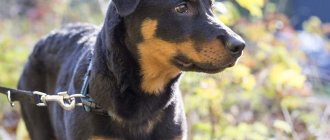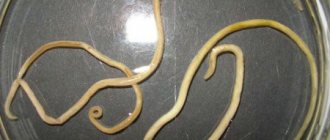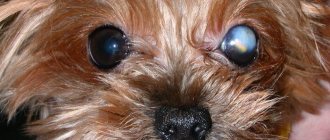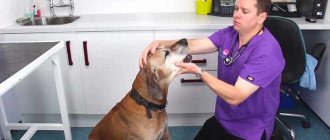01/21/2021 31,703 Diseases and treatment of dogs
Author: Olga
It is very scary to see when your beloved pet begins to experience involuntary muscle contractions, in other words, seizures. All breeds of animals are susceptible to this disease. What are seizures in a dog, and what can cause them? To begin with, we will tell you what it is and then you will learn how to behave, what to do, and how to help your beloved animal in such a terrible moment.
[Hide]
Types of seizures
From a physiological point of view, cramps are involuntary muscle contractions that are accompanied by pain and loss of consciousness. The main cause of this pathology is considered to be a disruption of the brain, so during the next seizure, convulsions affect many organs and systems. Depending on the external manifestations and severity, the following types of seizures are distinguished:
- Tonic convulsions . Usually these are muscle contractions of the dog's hind legs, in which the spasm leads to fixation of the limb in one position. The main symptom is that the paw is extended or bent in an unnatural position for a long time.
- Clonic . This is always a short-term attack of muscle contraction, which alternates with a relaxation phase. May affect both front and hind legs.
- Epileptic seizure . It is triggered by an incurable disease of the animal’s brain. The next attack is accompanied by increased salivation, foam at the mouth and profuse vomiting.
- Convulsions . This group includes short and alternating contractions of all muscles of the body. Loss of consciousness usually does not occur, but spasms occur throughout the body.
If cramps affect only certain muscle groups (fore or hind limbs, abdominals, neck), then they are called localized. In the event that the entire body is in hypertonicity and the animal loses consciousness, the spasm is considered generalized. Convulsions can also occur during sleep, before death - this is a normal physiological reaction of the body.
What are seizures and their symptoms
A cramp is a muscle contraction that is uncontrollable by an animal. It is associated with disturbances in the animal’s brain activity and is a symptom of a serious disease.
Seizures can manifest in different ways. From seemingly completely innocent twitching of the facial muscles and imperceptible twitching of one paw, to very frightening seizures in which the pet falls, convulses and has absolutely no control over its body. During moments of convulsive seizures, the owner can be very frightened, because seeing how a beloved pet suffers is unbearable.
Causes of seizures
Strong muscle contractions cannot occur by accident; it is always a consequence of a serious illness or exposure to external factors. The main causes of seizures in dogs:
- Epilepsy. A chronic disease that can be congenital or resulting from traumatic brain injury or tumors in the brain. The disease can lead not only to systematic seizures, changes in behavior, but also urinary or fecal incontinence, and visual impairment.
- Poisoning. Attacks caused by toxic substances entering the body are accompanied by indigestion, weakness and paleness of the mucous membranes.
- Diabetes. Convulsions during hypoglycemia can be caused by an acute lack of glucose in the dog's body.
A serious attack can result in paralysis of the limbs or coma; it is important to provide first aid in a timely manner.
- Infections. This is an infection by a virus, bacteria or fungus. Some diseases of this nature cause hypertonicity of the whole body. That is why after a tick bite you should undergo laboratory tests to rule out borreliosis or encephalitis.
- Metabolic disorders. Any metabolic disorders lead to permanent changes in the dog’s behavior. Typically, before an attack, you may notice increased thirst, digestive problems, and changes in heartbeat. When examining blood, a decrease in hematocrit and other blood parameters is observed.
In addition, seizures in dogs can be caused by pathologies of internal organs. Another attack of muscle contractions is a common symptom of diseases of the heart, central nervous system and liver. Convulsions are often observed after anesthesia, as well as after childbirth.
If your pet has had at least one case of body hypertonicity, then a full diagnosis is required.
It allows you to promptly detect serious illnesses, select the necessary treatment and prolong the dog’s quality of life.
Seizures in small dog breeds
All breeds of dogs are susceptible to various spasms, since spasms are not a disease, they are only a symptom of the disease. Small breed dogs are in a unique risk group, susceptible to the manifestations of spasms. Many dwarf dogs develop chronic diseases from birth. They also have problems with the spine, congenital hypoglycemia, arthritis, underdeveloped paws, problems with the cardiovascular system, atrophy of the muscular corset and many other ailments.
This is why small breeds are at risk. These problems lead to spasms to varying degrees. Small dogs may experience seizures more often than their larger dogs. Remember that when you adopt a small dog, you should be prepared for frequent seizures, writhing limbs and frequent visits to the veterinarian. It is also worth noting that owners of large breeds should also pay attention to the muscular condition of the pet.
What to do?
Any muscle spasms in a dog require a veterinary examination; self-medication is not recommended. If the attack lasts more than 7-10 minutes, the dog has lost consciousness, then you need to go to the clinic as soon as possible. It is often possible to determine the onset of the next attack in advance. The animal's behavior changes and there is a refusal of water and food. It behaves restlessly, salivation increases and foam appears at the mouth.
Owners of pets with chronic or congenital diseases, as well as older dogs, should be especially careful.
Video “Epilepsy attack in a dog”
The video shows a spasmodic attack in an animal of the husky breed. The owners are trying in every possible way to help their pet, as this is described in first aid for seizures. The main thing is to calm the animal and yourself!
Was this article helpful?
Thank you for your opinion!
The article was useful. Please share the information with your friends.
Yes (100.00%)
No
X
Please write what is wrong and leave recommendations on the article
Cancel reply
Rate the benefit of the article: Rate the author ( 10 votes, average: 4.30 out of 5)
Discuss the article:
First aid
Muscle spasms, other than those occurring during sleep, require immediate attention and medical attention. Helpful tips if you notice that your dog is twitching and convulsing:
- lay the animal on a flat horizontal surface, turn it over on its right side;
- carefully inspect the mouth; there should be no remains of food or objects in it;
- eliminate loud sounds and other irritants that can intensify the course of an attack;
- in case of severe convulsions, hold your limbs and head;
- put a few drops of Valocordin or Corvalol on your tongue.
If hypertonicity persists for more than 10 minutes, you need to take your dog to see a veterinarian. If you are diagnosed with, for example, epilepsy, you should have anticonvulsant medications at home, which ease the course of spasms and reduce the risk of death.
conclusions
Cramps are not a disease, but only a symptom. Leaving this sign unattended is extremely dangerous. Hoping that this happened once and will not happen again is unreasonable. Starting self-treatment is fraught with aggravation of the disease. It is important to get more information about the possible causes of cramping and decide what to do next.
In addition to medical care, the little friend needs emotional rehabilitation. Lack of control over one's own body, pain, and loss of consciousness lead the already weak animal into a state of shock. Maximum care should be taken. Talk calmly, kindly. Praise and hug gently. And the main thing is to be nearby.
The owner must understand that seizures are a manifestation of the disease and not hope that this was a one-time incident. The dog needs help both urgently and permanently. If the attacks are ignored, the animal will suffer and die as a result. At some point, coexistence with people will become impossible due to the manifestation of an advanced disease. Then it will be too late to contact the veterinarian. Treatment requires timeliness.
Read more: How to stop epileptic seizures in dogs
Survey
Competent diagnosis allows you to determine the causes of seizures in a dog and select the most appropriate treatment. Since the sign can be caused by a whole range of reasons, a comprehensive examination of the animal is always carried out. The most informative methods:
- MRI and CT scan of the brain and spinal cord;
- Ultrasound of the abdominal cavity;
- radiography of the skeletal system;
- ECG;
- clinical and biochemical blood tests.
If muscle spasms are observed on an ongoing basis, diagnosis should be carried out at least once every six months. It is especially important to see a veterinarian for small breeds and older animals that are prone to seizures.
Non-dangerous causes of limb tremors
Minor trembling of the limbs is rarely dangerous. It is mainly characteristic of Yorkies and Chihuahuas. If an alarming symptom quickly disappears, try to look for the cause in physiological factors or a psychological state.
Physiological factors
Tremors are often caused by temperatures that are too high or low. The scorching sun can cause your pet to suffer from heatstroke. It is safer to walk him in the mornings or evenings, when the sun is just rising or has already set. Hypothermia does not always occur on the street. If you forget to thoroughly dry your dog after bathing, then even a thick undercoat will not help him stay warm.
Sometimes animals tremble due to pain. This is typical for dogs that have recently undergone surgery or for pets giving birth. In such cases, you need to be vigilant: if other alarming symptoms appear, it is better to consult a veterinarian. Shaking paws can occur not only due to pushing and contractions, but also due to complications associated with labor.
Psychological condition
If an animal experiences vivid emotions, then its body actively produces cortisone and adrenaline. These substances speed up metabolism and heart function. When they enter muscle tissue, they provoke involuntary contraction. This occurs during:
- Stress
. The dog's condition is accompanied by apathy or severe agitation. Animals are usually unsettled by moving to a new place, a change of owner, or the arrival of a new family member.
- Sexual heat
. Males who notice a leaking bitch will try to break off the leash. In anticipation of mating, their hind legs may shake, imitating the movements during mating.
- Sleep
. Rapid paw contractions during sleep are normal. A four-legged pet can dream of a very exciting chase.
- Frightened
. The dog may be frightened by loud noises, a stranger, or a dangerous four-legged opponent.
- Joy
. A slight trembling can be noticed in a pet that meets its owner at the door. Yorkie and dachshund puppies are especially emotional. In addition to tremors, their excess of feelings is accompanied by squealing and involuntary emptying of the bladder.
You should seek help from a veterinarian only in cases where the animal’s condition begins to deteriorate. The appearance of new symptoms indicates pathology.
Treatment
Attention! Before use, consult a specialist!
The choice of treatment methods is selected depending on the characteristics of the seizures, the age and weight of the dog, as well as the presence of chronic diseases. Therapy comes down to relieving symptoms and preventing another attack. The most effective method is considered to be intramuscular administration of anticonvulsants, for example, magnesium sulfate (magnesium). When making a diagnosis, specialized drugs that affect the central nervous system may be prescribed: Phenobarbital, Diazepam, Pagluferal-1. These are psychotropic medications that are prescribed only by a doctor and require a prescription.
Medicinal self-medication of seizures and epilepsy is contraindicated and can be dangerous to the dog’s health.
Throughout active therapy, nutrition should be normalized and free access to water should be provided. If a dog exhibits accompanying symptoms – urinary and fecal incontinence, joint problems, vomiting – then targeted medications are prescribed. After another attack, droppers with Hartmann's or Ringer's solution are recommended to restore metabolism and general well-being.
If a dog bites or grabs a frog
The body of an ordinary garden frog is covered with protective mucus, due to which there is abundant and active production of saliva and the formation of foam. This process occurs due to the irritating effect when a dog takes a frog into its mouth (the common toad, fire-bellied frog and gray toad are especially dangerous).
You can give your pet a weak solution of potassium permanganate to drink or use activated carbon - based on a tablet per 10 kilograms of weight. If the dog resists, you need to pour potassium permanganate into the mouth using a syringe.
Prevention
If your dog has had convulsions, then you should adjust your lifestyle and diet - this is the only effective measure to prevent another attack. If possible, you should spend as much time as possible outside with your dog, and be sure to play active games. The daily diet should be balanced; it is best to switch to ready-made dry food - they contain all the necessary micro- and macroelements for the normal functioning of the body.
For dogs that are fearful and prone to nervous disorders, it is imperative to reduce the number of stress factors.
Try to avoid severe fears and stress, and eliminate loud sounds.
In this case, walks should be planned in advance - the route should pass through quiet places.
Metabolic disorders can cause seizures in dogs
White foam at the mouth
The white foam represents excessive saliva or stomach mucus, which has protective properties. They arise due to the influence of oxygen. Bubbles begin to form from the air and turn into foam.
Take the Attention Test! Find 10 differences! (click right here!)
Find the answer Are you bothered by some problem or question? Enter “Breed” or “Name of the problem” into the form, press Enter and you will find out everything about the issue that interests you.
She is not something dangerous. It's all about the reasons for its occurrence, which can be physiological, contagious or non-contagious.
A number of physiological reasons include:
- In a dog that has suffered a severe nervous shock or experienced severe stress, the formation of saliva and the foam that comes out with it may be triggered;
- Nausea and motion sickness, which arise due to long and frequent transport, lead to the release of saliva with foam;
- The body's reaction to tablets and syrups that have a salty or bitter taste. The taste buds are irritated, and saliva begins to foam when interacting with air;
- In a pregnant dog during toxicosis, the phenomenon in question can be observed;
- In breeds (boxers, bulldogs, basset dogs and others), due to the specific anatomical structure of the mouth, the flow of saliva is a constant and common occurrence. The secreted saliva turns into foam due to the movement of the jaws and due to the reaction to interaction with air;
- Prolonged fasting leads to the appearance of foam. Excess gastric hydrochloric acid, which has not had time to be used up due to lack of timely nutrition, is adjacent to the protective mucus, which collects in the stomach and comes out in the form of bubbles;
- Indigestion in dogs of small breeds or a sudden change in diet, the appearance of a new product in it will be the body’s reaction to unexpected changes. White foam comes out with belching and flows out of the mouth in small quantities. You can observe in the dog’s behavior: the animal often licks itself, but its physical condition does not change. The pet remains active and has an appetite
Which breeds are prone to muscle spasms?
Seizures can occur in any dog, regardless of external features. It is believed that representatives of small breeds are prone to muscle spasms: Chihuahua, toy terrier, Yorkshire terrier. The risk of convulsions is higher in males and older animals.
A predisposition to epilepsy is observed in the Golden Retriever, Poodle, Dachshund, German Shepherd, and Irish Setter. If your pet has had at least one case of an epileptic seizure, you need to be prepared for lifelong therapy - this disease is currently incurable.
If you ate a frog
You just need to rinse the mouth with plenty of water; you should not allow the dog to swallow or drink the liquid, as this may aggravate the problem. After copious rinsing with water, the reaction will go away.
It is worth keeping in mind that, as a consequence, an allergic reaction to the protective mucus of the frog may develop. The dog's tongue may become numb and its eyes may become swollen.
If such phenomena are observed, it is necessary to take her to the veterinarian, where the doctor will administer an antidote. Or you need to give your pet an antihistamine and observe the pet's behavior for several days.
Briefly about the main thing
- Cramps are involuntary muscle contractions that may be accompanied by loss of consciousness, vomiting and increased drooling.
- Depending on the causes and external manifestations, tonic and clonic convulsions, epileptic seizures, and convulsions are distinguished.
- If your dog is having a seizure, you need to place your pet on a horizontal surface. See a doctor as soon as possible.
- Before prescribing treatment, a complete diagnosis is carried out. Therapy for seizures is always medicinal, and prevention comes down to lifestyle and nutrition adjustments.
- Some breeds are prone to seizures. Muscle spasms are more often observed in small dogs and older individuals.
Have you experienced seizures in your dog? Share in the comments which treatment was most effective in your case.
Seizure
Increased convulsive readiness can be provoked by pathological activity of neurons in those parts of the brain that are responsible for the motor control system. The magnitude of a convulsive attack can vary: from mild twitching of the muscles of the limbs to severe generalized seizures with loss of consciousness. It all depends on what size part of the brain is affected by the disease.
A classic attack consists of the following main stages:
- Aura. This is the period when seizures are approaching. It can be recognized by increased anxiety and increasing trembling of the limbs. It can last from a few minutes to several days.
- Hit. This is an acute period. Symptoms appear with the greatest brightness. The convulsions are particularly severe and the dog may lose consciousness. This stage is characterized by uncontrolled urination and increased salivation.
- The post-traumatic stage is a state of “stupefaction”. It is characterized by wandering of the animal, loss of orientation in space, confusion, and severe headache. May last for several hours.
Single, infrequently recurring attacks of convulsions are not life-threatening. But there are acute conditions called convulsive status. It is characterized by constant or frequently recurring attacks. In this case, the dog needs urgent medical attention.
"Safe" convulsions
If a dog's paw twitches while sleeping as a puppy, this is evidence of the immaturity of the part of the central nervous system responsible for the movement of norepinephrine in the brain. This substance is produced by the adrenal medulla, but due to the same immaturity, too much of it is released at the moment when the puppy experiences strong emotions.
The baby, like a child, absorbs everything that the world around him offers, falls asleep, relaxes, and the subcortex at this moment still works. Emotional outbursts are expressed in the form of muscle tremors, involuntary movements, and stretching.
In addition to young dogs, similar conditions can occur in adult dogs with an easily excitable psyche. Zoologists explain this phenomenon by disturbing dreams and call it “puppy” tremors. It is not considered a pathology if development proceeds according to norms, but it can manifest itself as whining in sleep, shaking of the paws and ears, and small twitches. It is enough to caress your pet, talk in a quiet soothing voice and the trembling will stop. It is recommended to take emotional, excitable animals out for walks in unfamiliar places more often - this strengthens the nervous system.
How to help your pet if he has seizures
If the attack lasts more than 10 minutes, the animal must be hospitalized immediately











